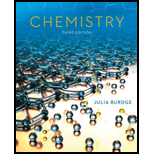
Concept explainers
How much copper metal can be produced by
Interpretation:
The number of moles of copper metal deposited during the electrolysis of copper ion solution is to be determined.
Concept introduction:
The relation between the current, time taken and the charge is as follows:
Here,
is second, the S. I. unit of time, and C is coulomb, the S. I. unit of charge.
The relationship between the number of moles of electrons and the number of moles of metal is as follows:
Answer to Problem 1KSP
Solution: Option (b).
Explanation of Solution
The reduction half-reaction for copper metal is as follows:
Therefore, two moles of electrons are needed to reduce one mole of copper metal.
The number of moles of copper metal deposited after electrolysis when 1.85 A of current is passed for four hours, is determined as follows:
The number of moles of electrons required to reduce copper metal is calculated as follows:
Now, the number of moles of copper metal reduced is calculated as follows:
Hence, option (b) is correct.
Reason for incorrect options:
Option (a) is incorrect because on solving with the help of the above equation, the answers do not match with option (a).
Option (c) is incorrect because on solving with the help of the above equation, the answers do not match with option (c).
Option (d) is incorrect because on solving with the help of the above equation, the answers do not match with option (d).
Option (e) is incorrect because on solving with the help of the above equation, the answers do not match with option (e).
Hence, options (a), (c), (d), and (e) are incorrect.
Want to see more full solutions like this?
Chapter 19 Solutions
Chemistry-Connect Plus Access
- Calculate the voltages of the following cells at 25°C and under the following conditions: (a) Zn|Zn2+(0.50M)Cd2+(0.020M)|Cd (b) Cu|Cu2+(0.0010M)H+(0.010M)|H2(1.00atm)|Ptarrow_forwardAn aqueous copper (II) chloride solution is electrolyzed for a period of 156 minutes. Using a current of 9.00 A. If inert electrodes are used in the process, how many grams of copper were removed from the solution?arrow_forwardOne of the half-reactions for the electrolysis of water is 2H2O (l)→ O2 (g)+4H+ (aq)+4e-. If 0.076 L of O2 is collected at 25°C and 755 mmHg, how many moles of electrons had to pass through the solution? (Answer should have 2 significant figures)arrow_forward
- When an aqueous solution of CuSO, is electrolyzed copper metal is deposited. If a constant current was passed for 5.00 h and 404 mg of Cu (63.546) metal was deposited, what was the current?arrow_forwardThe passage of a current of 0.750 A for 25.0min deposited 0.369 g of copper from a CuSO4 solution. From this information, calculate the molar mass of copper.arrow_forwardHow many grams of copper metal will be deposited from a solution that contains Cu2+ ions if a current of 0.733 A is applied for 69.3minutesarrow_forward
- An aqueous solution of gold nitrate is electrolyzed with a current of 0.555 ampere until 1.32 g of gold has been deposited on the cathode. If the atomic weight of gold is 197, determine the duration of the electrolysis in minutes ( 2 decimal)arrow_forwardA constant current of 0.445 A is passed through an electrolytic cell containing molten BaCl2 for 21.9 h. What mass of Ba(s) is produced? The molar mass of barium is 137.3 g/mol.Provide your answer rounded to 3 significant digits.arrow_forwardCopper is electroplated from CuSO4 solution. A constant current of 4.28 A is applied by an external power supply. How long will it take to deposit 1.00 ×102 g of Cu? The atomic mass of copper is 63.546.arrow_forward
- How many grams of cobalt metal will be deposited from a solution that contains Co2+ ions if a current of 0.974 A is applied for 67.4 minutes?arrow_forwardA current of 5.48 A is passed through a Cr(NO3)2 solution for 1.90 h. How much chromium is plated out of the solution? mass of chromium:__________arrow_forwardAn electroplating solution is made up of nickel(II) sulfate. How much time in minutes (DON'T INCLUDE UNIT IN ANSWER, 2 decimal places) would it take to deposit 0.500 g of metallic nickel on a custom car part using a current of 3.00 A?arrow_forward
 Chemistry: Principles and ReactionsChemistryISBN:9781305079373Author:William L. Masterton, Cecile N. HurleyPublisher:Cengage Learning
Chemistry: Principles and ReactionsChemistryISBN:9781305079373Author:William L. Masterton, Cecile N. HurleyPublisher:Cengage Learning
